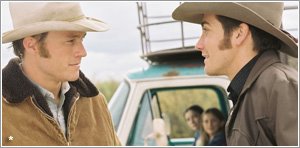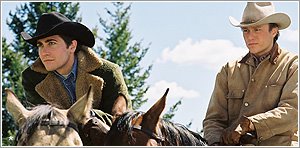From Heartbreak To Triumph On Brokeback Mountain

Based on a short story by Pulitzer Prize-winning author Annie Proulx, director Ang Lee's Brokeback Mountain is a poignant tale of forbidden love. Ennis Del Mar (Heath Ledger) and Jack Twist (Jake Gyllenhaal) are two young men who meet while herding sheep in the high country of Wyoming in the 1960s, setting off a complex and heartrending relationship that lasts more than 20 years. Dylan Tichenor, editor of Brokeback Mountain , describes the film's emotional core: “Ang tried to make an American love story without any sort of modifier on it, and that's what he did. Sure, it's a gay love story. The characters are cowboys, but it's not what you might think. This movie is universally applicable. You forget it's about two guys; it's about the fate of two hearts. It transcends gender.”
As moving as this tale is on screen, there was an emotional story in the editing suite as well. Editor Gerri Peroni, who began editing the film, passed away toward the end of production, and Tichenor, who had worked as Peroni's assistant early in his career, took over. “It was a great way to honor Gerri - working with her material on the movie,” says Tichenor, who shares editing credit with Peroni on the film. “When I was an assistant, I worked almost exclusively with her [on The Player , Short Cuts , and Prêt-à-Porter ], and that is part of what makes our work on Brokeback Mountain work together. We have similar sensibilities in terms of pacing, and so on. I looked at all the dailies and understood why she chose what she chose. I would have made the same choices. She had done a fair amount of assembling, and a lot of her work remains in the film.”
Peroni had used an Avid Film Composer XL system, so Tichenor - who has 12 years of editing experience on Avid editing systems - was able to quickly get up to speed when he joined the project shortly after production ended. The dailies and assemblies were organized in a familiar bin structure that enabled him to quickly view and access all of the source material and initial cuts. First assistant Kimberly Tomes and assistant Beth Moran each used a Film Composer XL system as well and they - along with two editing room assistants, Kate Abernathy and Geoff Sledge - were essential to the editing process.
“This movie is universally applicable. You forget it's about two guys; it's about the fate of two hearts.”
- Dylan Tichenor, Editor, Brokeback Mountain
A Universal Story
With a script from Larry McMurtry and Diana Ossana and outstanding performances from Ledger and Gyllenhaal, as well as from Michelle Williams and Anne Hathaway, who play their wives, the story hinges on the rich development of characters. “I think this is a movie about nuance and performances,” says Tichenor, who worked side by side with Lee in the editing room, using the Film Composer system as a tool to evaluate takes and explore creative options together in day-long sessions. “[Crafting nuance and performance] is something I take pride in; something I try to be good at. Ang was also incredibly generous during this process. He's very open to what people think, and he really valued my opinion. Working with Ang was a great experience for me. He has such depth of understanding of story.”
Tichenor continues, “It was especially important to craft this material into what people say the film has become - a universal love story. We didn't want the homosexuality to be pushed over the top. Editorially, it was about how much interest do they show in each other and when. How many looks were exchanged? Were there enough, but not too many looks? You want their first get-together to be a surprise, but not totally out of the blue. All of that is about crafting performance and story arc. It also takes place over a long period; the story spans 20 some-odd years. These characters go from being kids to being adults with kids of their own. The challenge was how to show the passage of time and go through, with a sort of shorthand, the story of the rest of their lives.”
Because of the film's relatively small budget of $13 million, the filmmakers agreed to control costs by foregoing film prints for dailies and screenings. Instead, all of the dailies were screened on the Film Composer system, and studio screening tapes were output to DVCAM directly from the Film Composer system. The quality of the Film Composer system's on-screen images and output enabled the filmmakers to work in the exacting detail required to create this visually striking film, which includes a range of scenes, from quiet private sequences to sweeping vistas that establish the raw beauty of the American West.
“The juxtapositions in this film - from the intimacy of two people to the vastness of the natural landscape - was emphasized by the wind.”
- Eugene Gearty, Supervising Sound Editor, Brokeback Mountain
Expansive Filmmaking
Some of the outdoor scenes required effects work to add specific visual touches to the landscape to match the storyline – for example, to enhance the shape or color of the clouds or to add hail. The Film Composer system's ability to easily handle these effects sequences was essential. “We did all the comps in the Avid,” says Tichenor, who worked closely with Montreal-based Buzz Image Group, a visual effects house that created approximately 75 effects shots for the film. “We made temp comps and gave them to Buzz with QuickTime references and DVCAMs, plus count sheets in FileMaker Pro. They give us back QuickTime sequences for the Avid and Cineon [files] for film out.”
Tichenor is quick to praise the skillful visual effects created by Buzz Image Group. He explains, “Buzz did a tremendous amount of work: sky replacements, set extensions, erasures. But the big thing was sheep replication. 700 sheep were on set; we needed 2,500 in some scenes.”
With the help of more than a dozen CG animation artists using multiple SOFTIMAGE|XSI 3D animation workstations, the artistic team at Buzz Image Group created approximately 15 shots with 3D sheep. Louis Morin, visual effects supervisor, visited the Calgary set several times during production to fully research the landscape and the shots required.
“Ang Lee is a master filmmaker and quite a perfectionist as far as framing,” says Morin, who worked tirelessly to create 3D shots that blended seamlessly with the film's natural scenic beauty, beautifully captured by cinematographer Rodrigo Prieto. “We did CG sheep enhancements in some shots - adding sheep in the mid-ground and background - and a couple of shots that were all CG. If we've done our job correctly, no one will know what we've done.”
The visual effects team, which included lead CG artist Pierre-Simon Lebrun-Chaput, lead compositor François Métivier, and compositor Ara Khanikian, relied on the SOFTIMAGE|XSI system's customization features to tailor the animation tools to help replicate clusters of 3D sheep while avoiding any visible patterns. “We used some in-house scripting, which worked well for this project. Scripting made the job easier, faster to render, and very manageable. SOFTIMAGE|XSI was the perfect tool for this size job,” he says.
The sounds of the American West were also vital for establishing the desired emotional backdrop for this story. “I would say that the critical sound component of the movie for Ang was wind,” says supervising sound editor Eugene Gearty, who also acted as sound designer, sound editor, and re-recording mixer on the film. “It was the most interesting, dramatic, and affecting sound that we worked with throughout the film. The juxtapositions in this film - from the intimacy of two people to the vastness of the natural landscape - were emphasized by the wind. We wanted to tell this story through the power of the wind - through nature's forces.”
Gearty relied on a Digidesign Pro Tools|HD system and its ability to work in 5.1 surround sound to fully develop everything from house-rattling gales to short, quick gusts. He also relied on the wide-ranging abilities of the Pro Tools system to handle multiple audio processes within one easy-to-use tool. “Because I'm the sound editor/sound designer/sound supervisor/mixer, I work with everything in a 5.1 pre-mixing environment. With Pro Tools, I can come up with a sound, balance it, and mix it all at once. You find yourself creating and designing while you are cutting. This was especially useful when I was working with Ang and Dylan, and I could make changes and show them everything at once. Using Pro Tools, there is a lot of room for creativity,” says Gearty, who shared supervising sound editing responsibilities with Phil Stockton at C5 in New York .
C5 also handled Foley, ADR, dialogue editing, and pre-mixing using a variety of Digidesign Pro Tools products, including multiple Pro Tools|HD and Pro Tools LE systems. As with the SOFTIMAGE|XSI files that were used for 3D animation, audio files from the Pro Tools systems were easily exchanged with the Film Composer system for an easy collaborative workflow.
An American Epic
Tichenor used an Avid editing system for the first time in 1993, working as an assistant on Mrs. Parker and the Vicious Circle . “The Avid is an extension of my fingertips at this point. I use a lot of keyboard shortcuts. I couldn't be any faster on it. It's just waiting on me,” he says.
On his current film, The Assassination of Jesse James by the Coward Robert Ford , Tichenor's setup includes three Avid Film Composer systems and the Avid Unity MediaNetwork shared-storage solution. He also plans to use an Avid Symphony Nitris system for HD screenings. “I can't wait to be editing on HD soon,” he says.
Wherever his interests take him, Avid systems will likely be there to help him achieve his goals. “Avid is an amazing program. It's revolutionized the art form. I just hope people realize that we do more things than ever as a result; not just faster, but more,” he says.
On Brokeback Mountain , Tichenor appears to have done plenty. This poetic epic has already received the prestigious Golden Lion Award at the 2005 Venice Film Festival and is widely anticipated to be one of the critical hits of the season.
“I'm just really proud of this movie. It meant a lot to me personally,” says Tichenor. “I was a huge fan of the story, which I read in a Best American Short Stories collection. When I heard Ang was doing the film, I thought ‘That is perfect.' When I heard Gerri was cutting it, I thought, ‘Great, that's perfect.' It was a crazy confluence of events that I ended up on this film, and it was a great experience on so many levels. Making this story into a film was a really tall order - and I think it really works.”



0 Comments:
Post a Comment
<< Home